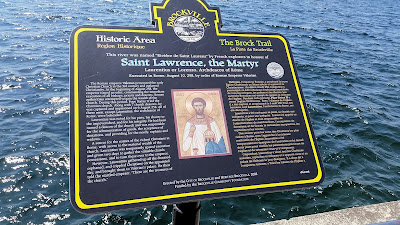Since we are living here for a few months I thought a few words and pictures about the Seaway would be appropriate. The St Lawrence river runs from Lake Ontario to the Atlantic Ocean. In its natural state it ran via numerous rapids and was therefore not navigable to anything but kayaks. Through two engineering efforts the Seaway provided deep water and locks around the rapids areas thus allowing large Ocean going ships to transit from the Atlantic Ocean to Lake Ontario. Such ships still found Niagara Falls an impediment so The Welland Canal was built thus allowing transit around the falls to Lake Huron. The addition of locks in St Mary's River allowed transit to the last of the Great Lakes opening up the entire region to ocean navigation and navigation to 100 million people.
A typical lock is quite interesting from a safety and maintenance point of view. Each end has dual gates, arrester wires and, on the upstream end, a sill barrier to protect the upstream end gates. This particular lock is at Iroquois. The upstream gate is the only thing holding back Lake Ontario when the downstream gate is open. The rise or fall at Iroquois varies from 6 inches to 5 feet depending on water levels.
Although the lock has two gates at each end only one is used. Each is independent and either can be used if the other fails or is under maintenance. In the above photo, the box in the foreground houses the back up generator used if local power fails. Keeping the Seaway open is a high priority due to the costs incurred by the users in the event of delay. No amount of back-up prevents the frequent delays due to groundings, ship equipment failure and navigation error. The following sequence shows the Algoma Equinox
transiting up-bound at Iroquois.
It's a very slow business. Ships have hit the arrester wires on a number of occasions and take things very slowly. Jo likened this transit as less interesting than watching grass grow.
The ship lines up for entrance using its bow thruster for assistance and enters at less than a knot of speed.
The stack of iron work just to the left of the bow in the above picture can be lifted into slots in the lock by the crane, one atop the other on the outside of the two movable gates thus providing a fixed wall to allow major maintenance of the lock. The same setup is in place at the upstream end. In this way all the gates could be removed at once.
This ship is popularly known as a Laker and is characterised by it's inelegant bow shape designed in the cause of economy. In the following panorama, Equinox is behaving like the plunger of a syringe. Both up-stream and down-stream gates are open as there is less than six inches difference; there is a slight current downstream and the ship fits the lock within six inches either side. Also, this ship was loaded so there was not much space underneath. All this means that the ship required considerable power to be applied to squeeze the water passed it just to make it through.
After a gruelling, very warm afternoon watching paint dry at Iroquois Lock we retired for a brew at Bud's on the Bay in Brockville and, wouldn't you know it, the Algoma Equinox passed by us. This is Daniella, one of the many fine servers at Bud's.
In the next post we will update with some news.








No comments:
Post a Comment
Thanks for leaving a comment. I have tried to reply to many but for some reason I can't. So please don't be offended if it seems I am ignoring you!